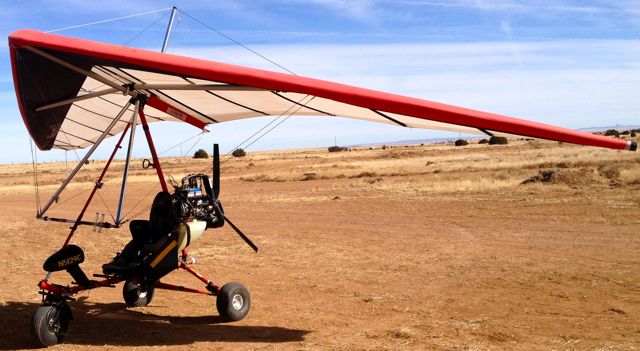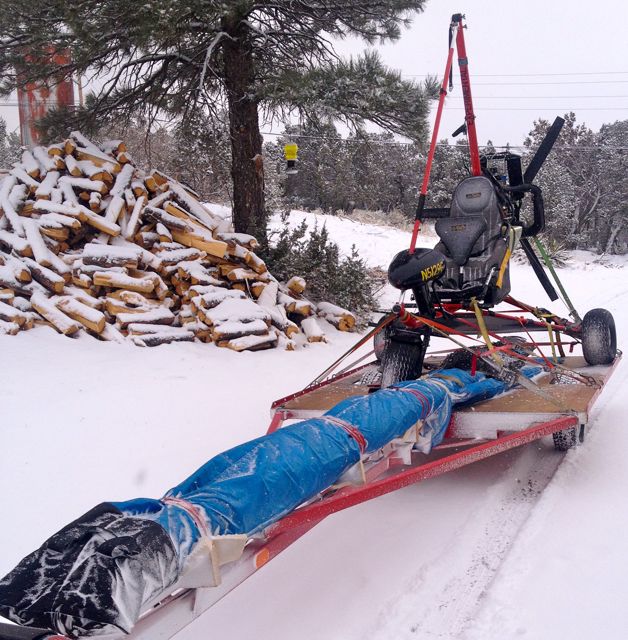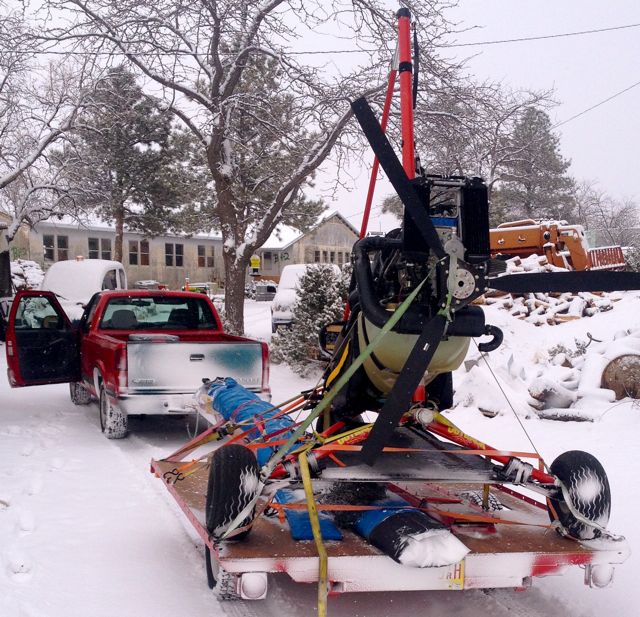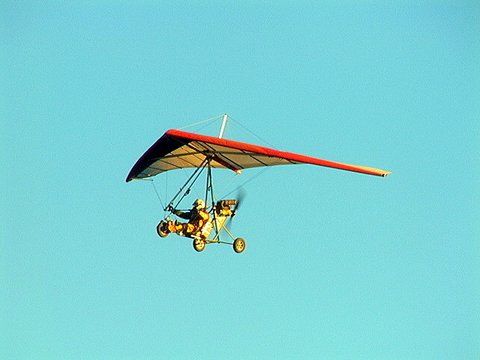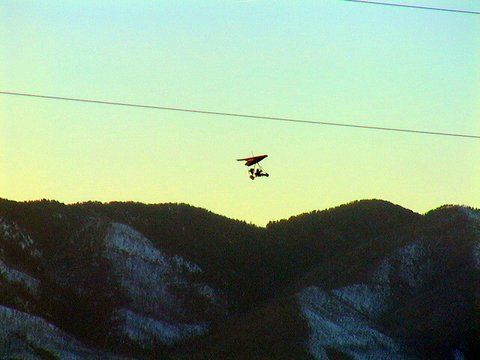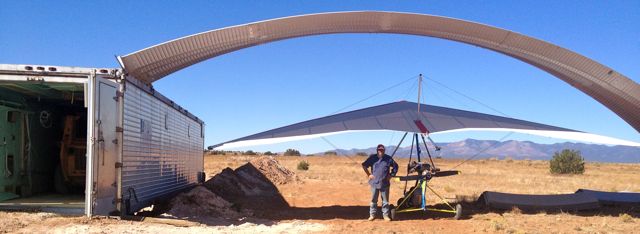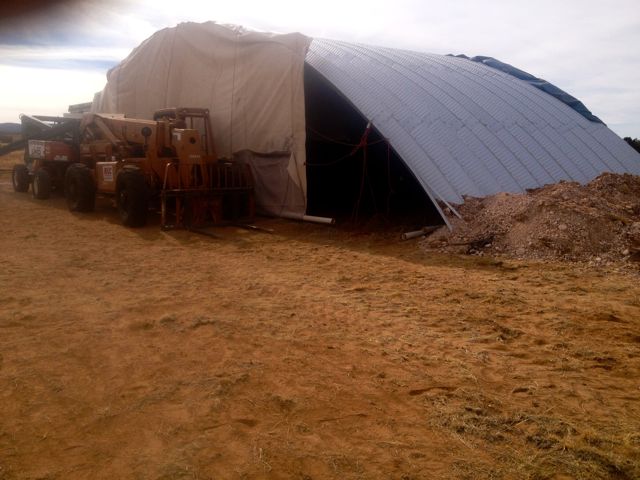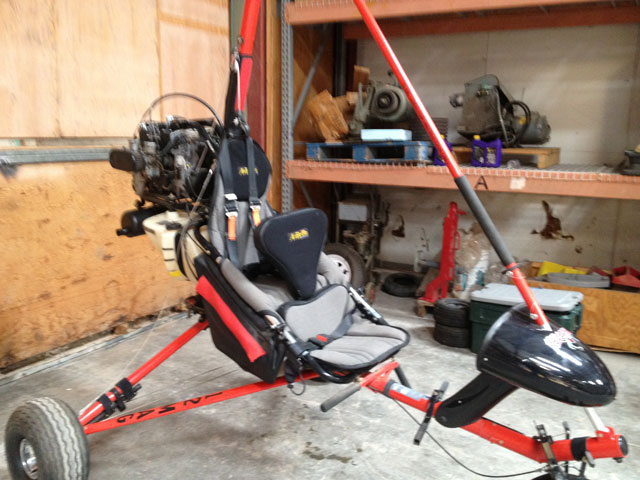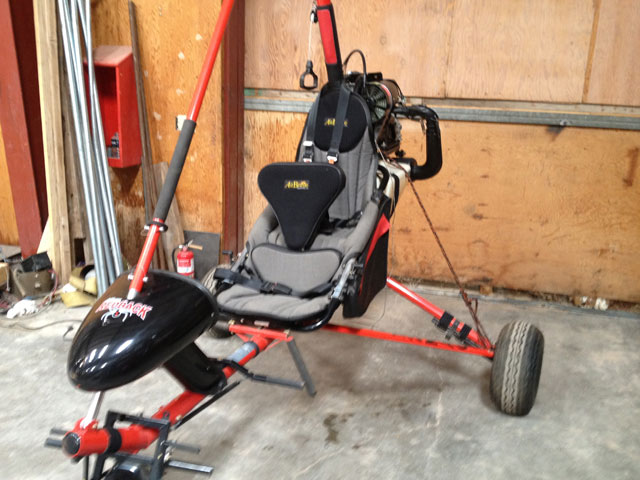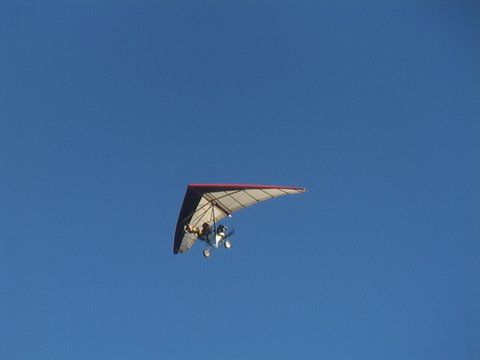
The image above is my first flight of the Mallard after all the things were done to get it to the place that I felt I had enough control to actually fly it some place--over the CAVLON warehouse property. Our inventory person Linda took this image. I made two flights on this day.
The Mallard ultralight has proven to be a challenge to fly. My first flight in it was a horrifying experience. It took me 45 minutes to get enough control to get it landed--most of that time I did not think I would make it back in one piece. The problem was extreme lateral PIO. It also seemed to take extreme control bar movement and a long delay to make anything happen. It was also a bit turbulent air by the time I got up which did not help. I went back up on a subsequent calm morning but experienced similar results, wishing I had not gone up the instant I was in the air. I did manage to land quickly on the first pass--ugly landing but all was still intact. My local ultralight buddy Claudio with a lot more trike time then flew it and had the same trouble. Took 3 passes to land. Said he would not fly it again.
There was a lot of discussion back and forth with others more knowledgeable about these things. We changed the hang point to the forward hole as the person I got it from could not remember where he had flown it--he assembled it in the middle hole when he brought it to me months ago. We did a hang test and found the CG was forward such that the front tire was only a couple inches above the rears. We moved the seat all the way back which got the nose about 8 inches high. Hop tests showed about 12 inches of air under the nose when the rears came off. The seat move meant I could not reach the pedals anymore so I turned some wood extensions out of a piece of firewood.
I had our instructor Frank come out and fly it. Even though he is vastly more experienced with a variety of trikes and wings, he also experienced the PIO problem. After an hour or so of flying, he got relatively on top the PIO problem--finding that it was extremely sensitive to control bar movement. Generally that it was necessary to take hands off the bar to get PIO to stop. Several had speculated that the Wizard 3 wing from a 2 place was just too much wing for a true ultralight trike. We grabbed a 50 pound bag of sand and Frank flew sitting on that. He reported considerable improvement regarding the PIO but had trouble reaching the pedals at that point. It also moved the cg forward such that the nose wheel landed only slightly after the rears. He said the trike was otherwise a very good unit and flew fine except for the control sensitivity. When flying without the extra weight, he could not get it to stall.
I found some lead sheets that weigh 25 pounds each and folded 3 of them into the back of the seat. These were behind the hang-point and moved me slightly forward for better pedal reach which left the CG just about in the right place.
I did some high-speed taxi and short just above the runway hops but it was about 10 days before there was calm enough wind at the right time for me to try it. That came on a Friday afternoon a couple weeks ago while I was working on the temporary hanger. The first flight was too the west and included the image above. I found that there was still a strong tendency to lateral PIO but it was manageable, primarily by just letting the control bar go. With no instruments, it was hard to know but I am guessing I was 500 feet and above. When I landed, the weather was still nice and Claudio had his trike out so we took off with him in the lead. I caught up with him a few miles out and went outside his turning to the east as I was going faster. He then went behind and above me and I soon lost him in the low sun. I headed away form where I figured he would be and made a big non-round circle about 7 miles to the North of the airport. I landed right about sunset--Claudio was already hangered and ready to drive away. About 2 hours of flight time that day--burned down to about only half a gallon left when I landed.
I added a little review mirror as I found that I could not look behind me with all my cold weather gear. The main issue being I could not see the fuel tank right behind the seat to know how much was or was not left. I added a sort of digital kitchen timer also as I had no way of knowing how long I had been flying. I also added an electronic AGL altimeter so that I can tell how much higher I am than the airport where I take off. I tried to add an automotive electronic compass, clock, temperature thing but it has fallen off twice in taxi tests so it is not getting mounted until I find a positive solution. I had previously added a rotor meter type airspeed indicator to the control bar.
Yesterday turned out to be the calmest day we have seen in a long time. I did a bunch of runway hops in the morning, about an hours worth and probably more than 20 times off the ground. Claudio and I headed back out to the airport about 3 pm and he took off and I followed a few minutes later. We had previously discussed what we would do and where we would go in the air so as to not run into each other. We had radios this time which worked great on the ground but not so well in the air. I could hear Claudio the whole time but not understand him about 50% of the time. He could not understand me at all and eventually could not even hear me. Found out that my radio battery was wimpy, providing enough power for me to receive but not enough to transmit. (I already have a new battery on order.) Claudio kept talking even-though he could not hear me so I had a general idea where he was the whole way. I stayed low, I am guessing about 300 feet (I forgot to set my new AGL altimeter before I took off) and Claudio was high (1500?) and behind. We headed East toward the 100 MW windmill farm SE of Willard. It was so calm some of them were not turning at all (first time I have ever seen that). By 10 minutes out, Claudio had lost site of me. I did some turns and he picked me up only to loose me again a few minutes later. I continued East below and about 3 miles to the North of the bluff the windmills are on. Claudio flew above and up to the first windmill. I turned back at about 30 minutes out and past most of the windmills. I went NE over the first of the mud flats. Then directly West just South of Willard and over a very large cattle operation I did not previously know existed.Once I crossed the railroad tracks, I followed them back toward Mountainair until I got close to the airport. I did a fast lowish pass over the runway to check our wind indicators and then straight on West, keeping North of the area I believed Claudio to be using. Once straight North of the CAVLON compound, I turned South and then circled over several times. I could see Linda running to get her camera so I circled a couple more times--but it was only enough for her to get one image. I would have circled longer but I could see in the mirror that my fuel was getting low--down to a gallon when I landed. I could hear Claudio on the Radio more clearly as I headed back to the airport so I knew he had already landed. I made about my worst landing yet--in the weeds--simulating and off-airport landing I guess. The trike is really tolerant to rough terrain, including running over some old tires.
A few conclusions at this point. It is still very sensitive to lateral control bar input and resulting PIO. If I do anything else like try to focus on something, look up at the wing, look in the mirror, find the push to talk button, etc. I start PIOing badly. Getting back off the bar stops it fairly quickly (in calm air). It is burning a good 2.5 gallons per hour. With the current hang point and weight, I have to run about 5800 rpm to maintain level flight.
